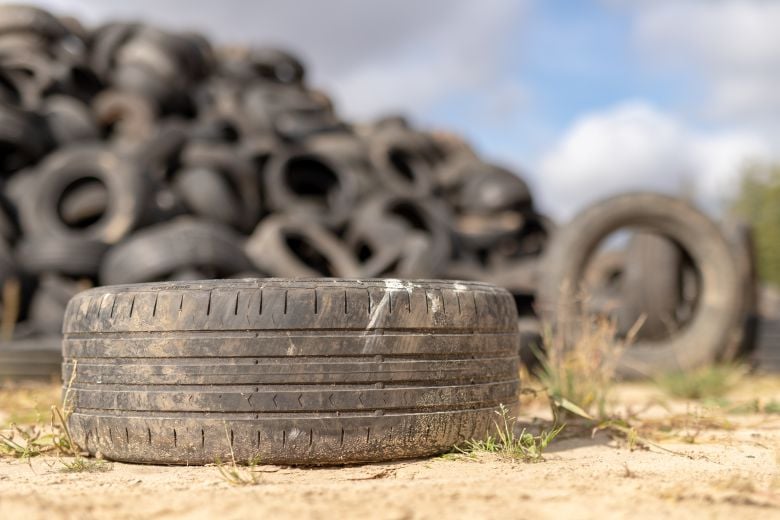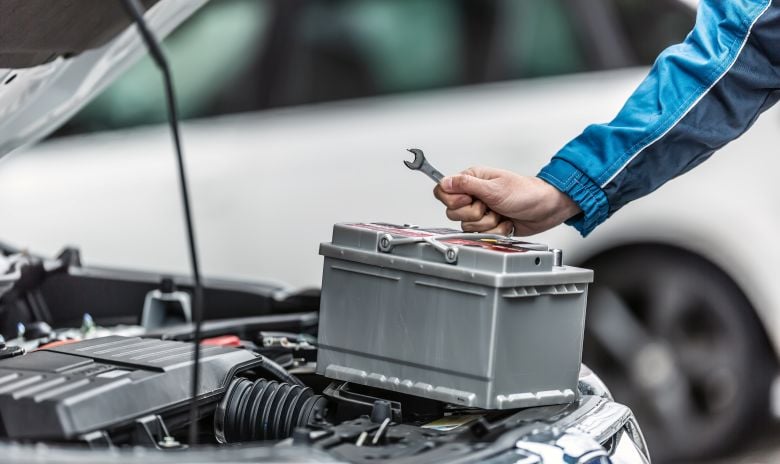
How to Safely Dispose of Tires, Batteries & Auto Waste
- Vehicle Maintenance
- PEAK
- March 11, 2025
Learn how to properly and safely dispose of used tires, batteries, and other components.
Automotive waste is a major environmental issue. Countless tons of solid waste emerge from the 283.4 million registered vehicles in the United States as components like tires, lighting bulbs, wiper blades, and batteries reach the end of their lives.
Drivers like you can have a positive impact. Knowing how to dispose of tires, used bulbs, wipers, batteries, and other automotive waste can reduce pollution, prevent environmental contamination, and protect public health and safety. This primer explains everything you need to know.


How to dispose of old tires
Entering used tires into local recycling programs is the best way to dispose of them. There are several ways to do this:
- Leave your old tires behind. Most tire retailers will accept your old tires for recycling when you buy new ones. For most people, this is the easiest and most convenient option.
- Contact your local transfer station or waste management agency. Tire recycling program availability varies, especially if you live in a less populated area. If you have a transfer station or resource recovery center nearby, it will probably accept used tires. You can also call the waste management agency in your municipality or county for local information.
- Check for upcoming bulky waste collections. Many localities operate periodic bulky waste collection programs. If you have one coming up soon, contact the program operator to ask about tire disposal.
If tire recycling isn't available locally, you can also take your tires to the nearest landfill. However, dumping fees may apply depending on where you live.
Call ahead to make sure the landfill accepts tires, and to find out if charges apply. If your local landfill doesn't accept tires, inquire about alternative options. They'll explain how best to proceed.
Are old headlights recyclable?
Headlights and headlight assemblies contain many different materials, making recycling more difficult. It isn't advisable to put used headlights or automotive lighting components in with your regular household recycling.
Here's what you can do instead:
- Contact your nearest municipal recycling center to see if it accepts automotive lighting waste.
- Check with auto parts retailers in your area. Many of them run in-house recycling programs for headlights and other forms of solid automotive waste.
- Try to resell assemblies and salvageable components to local buyers. Car restoration enthusiasts and thrifty consumers may be interested in them.
If none of these options work, you can dispose of used headlight bulbs with your regular household garbage.
When it's time for new headlights, PEAK Auto has you covered with capsule headlights in a full range of brightness ratings and complete exterior and interior lighting solutions.
What to do with used wiper blades
For peak performance and visibility, you should replace your wiper blades every 6–12 months or whenever they show signs of wear. PEAK Auto also has you covered here, with a complete lineup of heavy-duty, high-performance wiper blades.
Once you've replaced your worn-out wiper blades, here's what to do with your old ones:
Recycle your old wipers
Wiper blades have metal, plastic, and rubber components. Some facilities have the capacity to recycle these materials simultaneously, while others do it separately. Check to see which standards your recycling center uses.
If you can recycle your wiper blades without separating the components, ask about the procedure for disposing of them. If you need to separate the metal, plastic, and rubber yourself, it's a fairly straightforward and intuitive job you can perform with a few common tools.
Any metal you're left with qualifies as scrap metal. It won't be worth much, so selling it to a scrapyard probably won't be worth your time. However, you can easily recycle it separately if your local recycling center doesn't accept wiper blades. Any other leftover components can be thrown out with your regular trash.
Donate your old blades for reuse
Some automotive service centers and parts retailers refurbish old wiper blades for community redistribution, or harvest their components for reuse. If your blades are worn out but still in otherwise good condition, this might be an option.
Choose wisely to reduce waste
Silicone wiper blades have stronger performance ratings than traditional wipers. They last longer, so you won't need to replace them as often. This creates less waste, making it a good idea for eco-conscious drivers.
To that end, consider PEAK Auto's Silicone Platinum or Silicone Plus wiper blades. Both offer excellent performance and long-lasting durability.


How to safely dispose of car batteries
Knowing how to safely dispose of batteries will become increasingly important as drivers shift to electric vehicles (EVs) in growing numbers. EVs use totally different battery systems than conventional gas-powered vehicles, creating an entirely separate set of best practices for safe disposal.
Safe EV battery disposal
EV manufacturers use different techniques to assemble their batteries. As a result, recycling processes are not standardized. However, there's one important universal truth to know about EV batteries: they cannot be put in landfills. EV batteries contain heavy metals, toxic chemicals, and many other hazardous pollutants.
Fortunately, most consumers aren't likely to throw their used EV batteries into the garbage anyway. Some of the metals they contain, like lithium and cobalt, are very valuable. Disposing of an old EV battery in a landfill would be like tossing gold or silver jewelry in the garbage.
Instead, contact your nearest auto recycling center or used battery depot. With EVs becoming more popular, these facilities are widely available. They'll accept your used battery and send it off to a specialized facility, where the battery's valuable and reusable components will be harvested and the remains will be safely handled.
Conventional car battery disposal
Drivers of conventional gas-powered vehicles usually dispose of their old batteries through their service center, when they buy a replacement battery. Service centers handle used batteries on behalf of their customers, and you can leave your used battery with them.
Because old car batteries contain valuable metals, some service centers and auto retailers even offer financial incentives to customers who leave their used batteries behind. It's more common for them to offer credit for products or services rather than cash, though.
If getting paid for your old battery isn't a priority, you can also dispose of yours at your local hazardous waste handling center. These facilities probably won't offer you anything for your battery, but they will dispose of it safely.
You can also take your used battery to a metal recycling center yourself, and collect cash for its valuable, recyclable, and reusable parts.
Before you handle the battery yourself, brush up on a few important safety tips:
- Always wear safety gloves when handling a battery
- Keep the battery far away from fabrics, including upholstery and clothing
- Immediately flush your skin with clean, lukewarm water for at least 30 minutes if you accidentally spill battery acid on it
If you notice a burning sensation after flushing your skin, contact your local poison control center immediately.
Connect with more eco-friendly motorist tips
At PEAK Auto, we're working to make our product lines more sustainable and eco-friendly, and to educate our customers on steps they can take to minimize their environmental impact. For more tips and info, check out our recent posts on vehicle sustainability trends and driving tips for maximizing your gas mileage.

